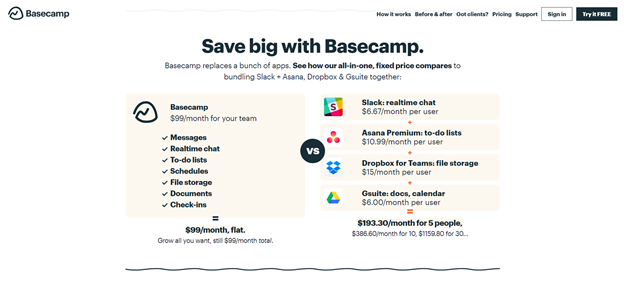Here’s a thought experiment you may be familiar with:
“If a tree falls in a forest and no one is around to hear it, then does it make a sound?”
The answer varies depending on whether you ask a scientist or a philosopher. Regardless of what the ‘right’ answer is, here’s the SaaS equivalent to that age-old question:
“If a SaaS product delivers a ton of value but no one is able to perceive it, then does it really deliver any value?”
Well, the answer to this question is a lot more straightforward: no.
Even the most useful SaaS product in the world might not attract sign-ups and stick-arounds if people don’t think it’s helpful for them. Of course, the problem with perceived value is it’s all very subjective.
How one customer perceives your product can differ very greatly from how another customer does. And despite your best efforts, there’s only so much you can do to influence customer perceptions.
Nevertheless, as the answer to our philosophical SaaS question shows, perceived value isn’t a wishy-washy concept you should write off entirely.
Improving customers’ perceived value of your SaaS business can have tangible impacts on your acquisition, retention, and recurring revenue for the following reasons.
1. Customers believe they’re getting a deal.
It doesn’t matter which industry you’re in—everyone loves a good deal.
If potential customers perceive they’re going to get a lot more value from your product than what they have to pay for it, then signing up becomes a no-brainer. Accordingly, this is great news for your customer acquisition and recurring revenue growth.
Your job is hence to communicate the value of your product in a way that makes it super obvious to potential customers.
Just take a look at this diagram on project management platform Basecamp’s pricing page, for instance.

- Basecamp lists a few competitors and how much they charge for their respective products.
- It then states how its platform can do everything its competitors can, but for so much cheaper.
Presented with this value proposition, a potential customer might go:
“Wow, Basecamp is such a steal! We’re going to save so much money using Basecamp. We have to get it.”
With such an incredible marketing and pricing strategy, it’s no wonder Basecamp has clocked over 3.5 million user accounts (and counting).
2. Customers feel your product meets their needs.
The ability to generate recurring revenue from your product isn’t just about securing those monthly payments. You need to give your customers a reason to stick around long-term.
As customers use your product, they need to see very clearly that your product is helping them achieve their goals.
And when they do, saying “yes” to renewal becomes a more straightforward decision—leading to greater customer retention and perhaps even monthly recurring revenue (MRR) growth and higher overall recurring revenue for your SaaS business.
Here’s an example to illustrate.
While marketing automation platform RD Station was doing a credible job of onboarding its customers, many customers stopped using some of the platform’s key features after that point in their journey.
This drop in usage suggested customers weren’t finding those features useful. And this was a problem because these were the main features that were supposed to drive the most value. Leaving the issue unchecked would likely have resulted in many of the company’s customers churning out.
“Customers that are underusing a solution from a feature-functionality standpoint are the most obvious risk [of canceling their subscriptions],” shares Chase Tinkam, founding Customer Success Manager at ChurnZero.
To tackle its underutilization problem, RD Station rolled out strategies to:
- educate customers about its product’s features, and
- run digital campaigns that helped customers visualize long-term success with the product.
The efforts paid off.
After customers began seeing more value in the product, the company experienced a 69.2% year-on-year increase in its adoption rate.
3. You can charge more for your products.
The higher your customers’ perceived value of your product, the more you’ll be able to charge for it without them balking at the price.
That said, your customers have to believe your product is actually worth the price they’re paying for it in the first place.
Customer service software Zendesk learned this the hard way. After making numerous improvements to its product over two and a half years, the business decided the time was right for a price increase.
So Zendesk announced the new prices to its customers…and faced backlash almost immediately.
Although the company was raising its prices to account for the new value it was providing its customers, it neglected to communicate this value to them adequately. And customers failed to see such value themselves.
Or, as marketer Guerric de Ternay put it:
Zendesk’s customers complained about the new price because their perceived value did not change. What they were paying for before and after the price changed was the same SaaS product.”
Accordingly, to customers, it looked as if Zendesk was raising its prices for no good reason—which hurt when some customers were looking at a price increase of as much as 300%.
Doing urgent damage control to mitigate the risk of mass customer churn, Zendesk quickly walked back the price increase for existing customers. This move likely saved it from seeing upset customers leave in droves and bleeding a significant amount of annual recurring revenue.
4. The path to going upmarket becomes smoother.
At some point in your journey of running a recurring revenue SaaS business, you may want to move upmarket and target the enterprise crowd. After all, that’s where all the big fish are. And landing one large account could be worth so much more future revenue than multiple smaller accounts combined.
When customer relationship management platform SuperOffice started to move upmarket, for example, it was able to raise its average contract value by 47%.
Marketing to enterprise customers almost always calls for different strategies from marketing to smaller customers. If there’s one thing that remains unchanged, however, it’s this:
You’ll have to help potential enterprise customers perceive the value of your product to persuade them to give you that recurring revenue.
Not sure how? Well, SaaStr’s Jason Lemkin has a suggestion for you:
“[Build] a dashboard. A really good one.”
In large enterprise organizations, the stakeholders who approve software spend are rarely those who use the software themselves. However, you can design a dashboard that shows how their organization is benefiting from your product.
“The dashboard should show ROI to the whole company so clearly, that even the CEO gets value from it. Even if she has never even logged into the app,” writes Lemkin.
“Think of a dashboard good enough to show at a board meeting. Make sure your core dashboard does that.”
Closing the gap between actual and perceived value opens opportunities for higher recurring revenue
No matter how useful your SaaS product is, customers have to see the product’s value for themselves. It’s only when this happens that they’ll sign up, subsequently renew, and hopefully continue to add more recurring revenues to your coffers.
It’s possible to close the gap between actual value and perceived value by enhancing your product—such as by building a dashboard, as Lemkin suggests.
However, the focus of your efforts should be on properly communicating your product’s value to customers, rather than tacking on an extra feature just for the sake of doing so.
Also, keep in mind the more hyped up your customers are over your product, the higher their expectations of it will get. That’s where your product will have to shine and actually deliver the value you’ve promised to customers.
The recurring revenue model is great for SaaS and subscription based businesses to generate predictable revenue, but the successful business leader knows this revenue needs to be earned. Ensuring the actual value your SaaS business delivers matches—and even surpasses—its strong perceived value is a winning formula that will bring customers in and keep them around for a long time.







